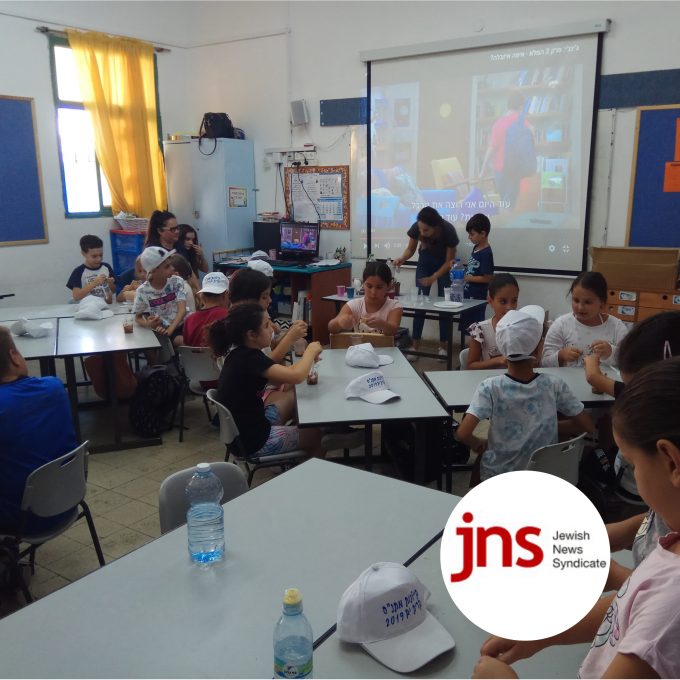It was the redness of the eyes that betrayed the children’s emotions as they stood for a minute’s silence outside the town of Slonim, Belarus; other traces of emotion mingled with the driving rain.
It was Yom HaShoah and the 200 ORT students and teachers from Russia, Ukraine, Belarus, Samara and the Baltic States had disembarked from the coaches taking them on this year’s Masa Shorashim (“Roots”?) tour of Jewish sites; the coach drivers sounded their horns, an echo of the sirens wailing across Israel at precisely the same time. They were among thousands of ORT students around the world remembering the martyrs and heroes of the Holocaust in ceremonies at their schools or by participating in special activities such as Masa Shorashim, which is funded by Israel’s Ministry of Education and the Conference of Jewish Material Claims Against Germany and implemented with the involvement of the Jewish Agency for Israel for all schools participating in the Heftsiba system, and March of the Living.
“The primary obligation is to remember,”? said ORT Marseille Principal Maurice Cohen-Zagouri, 21 of whose senior students were in Poland on Yom Hashoah with March of the Living. “This generation is perhaps the first where even the parents didn’t experience the Shoah. It’s very likely that they don’t speak about it at all at home. It’s therefore the role of Jewish schools to pass on this history so that young people are aware of it and learn to fight for humanity. If we don’t fulfil our obligation to remember then, in a few years, the Holocaust deniers will win.”?
Among the other 11,000 students on the March of the Living between Auschwitz and Birkenau were 150 from ORT Argentina. They had left Buenos Aires on Monday a bundle of contradictory emotions and had barely touched the ground before they were taken to a surviving fragment of the Warsaw Ghetto wall. From that symbol of horror and dehumanisation they travelled to Tykocin where they caught a glimpse of pre-war shtetl life and then on to the woods a few kilometres away where the village’s 1,400 Jews were slaughtered and buried on August 25, 1941. At each site, “emotion invaded our hearts”?.
Back in Buenos Aires there was more emotion as the ORT schools commemorated Yom HaShoah in a special ceremony featuring Helen Gutkovsky, who survived the Shoah as a hidden child. Two of her grandchildren are ORT students.
“There were a lot of tears,”? an ORT Argentina spokeswoman said. “You can imagine that it can be difficult sometimes to keep hundreds of children quiet and focused but today you could hear a pin drop. The children were deeply moved.”?
The ceremony noted that this year was the 70 th anniversary of the Wannsee Conference at which senior Nazis mapped out the practicalities of the “final solution to the Jewish question”?. But the heroism of the partisans was also remembered as was that of Janusz Korczak (Henryk Goldszmit), the paediatrician and author who refused to abandon the children of the orphanage of which he was director as they were taken to the gas chamber.
As confronting as it is to learn of the Holocaust at school, to visit the actual scenes of savagery can be a deeply shocking experience and debriefing sessions are organised to ensure that the children learn how to cope with their history.
“When they are there the kids are silent, speechless,”? said Mr Cohen-Zagouri, whose school has participated in March of the Living for 12 years. “They have been preparing for this all year, learning about the places they are to visit but even those who think they know what to expect, when they actually see the crematoria, the piles of shoes and hair, it has an effect. For some it can take a few weeks to be able to open up with their feelings so we arrange a meeting after the trip to allow discussion…
When the children are there it’s raw and very hard to see but they have to face it head-on: it’s the reality of our history.”?
And yet, for most, the experience is not, ultimately, a negative one. For Pavel Duslaski, 17, a student at the ORT Tallinn school in Estonia, the Masa Shorashim tour “モ which featured famous and infamous names in European Jewish history including Volozhin, Mir, Grodno, Kovno and Katyn “モ gave him the chance to reach back into family history.
“You learn about it in school and see films, read books but it’s much, much more powerful to see these places,”? he said while on the coach to Minsk on Yom HaShoah afternoon. “You can feel the presence of the Jews who lived and died here and your imagination is working. My great-grandmother was killed in Minsk but my grandmother managed to run away. It’s good that I can be here now and can say to my great-grandmother, “リI am here, your family survived and we remember you’. Some people cry when we visit these sites and sometimes we feel scared but we are proud to be Jewish.”?
Pavel was not the only one with a person story to tell. The Israeli Ministry of Education’s Dr Tova Peralmuter, who organised the programme, addressed the children on the morning of Yom HaShoah.
“I am the daughter of two Holocaust Survivors and I was born in a Displaced Persons camp in Germany. I told them that Yom HaShoah was the yahrzeit for my family which was murdered,”? Dr Peralmuter said.
But, she added proudly, all the children could sing the words of HaTikvah by heart at the conclusion of the ceremony: “It’s so touching, so emotional.”?





